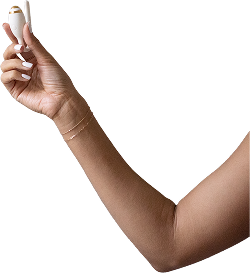The Power of Cervical Mucus Tracking
kegg works by detecting changes in cervical mucus—the key indicator of fertility. Unlike ovulation predictor kits (OPKs) or basal body temperature (BBT) tracking, which only identify ovulation after or very close to when it occurs, kegg uses your body’s earliest and most reliable fertility signal: cervical mucus. This allows you to spot your fertile window before ovulation happens, giving you the best chance to time intimacy or insemination for conception.
How does it work?
Through advanced sensing technology known as impedance, kegg measures subtle changes in your cervical mucus.
Each cycle is a complex orchestration of events. While ovulation is the main event, it may surprise you to learn that your best chances of conceiving are actually in the days before ovulation.

What does cervical mucus have to do with conception?
Quite a lot! Cervical mucus plays a vital role in conception, as sperm survival depends on it. Fertile cervical mucus can nourish sperm for up to 5 days. The most fertile cervical fluid typically appears 2–3 days before ovulation, which is when a woman’s chances of conception are highest.¹
As ovulation approaches, cervical mucus becomes more abundant, wet, and slippery. Unlike infertile mucus, which blocks and hinders sperm, fertile mucus nourishes sperm, protects them from the vaginal environment, and helps the healthiest sperm travel toward the fallopian tubes.
By timing efforts in advance of ovulation, you give sperm the best chance of being present when the egg is released. Unlike BBT and LH tests, kegg both predicts fertile days in advance and shows in real-time the full duration of your fertile window.

Your Cycle Data
The kegg app brings together multiple data points to help you confidently understand your cycle and fertile days.
Fertile Window
Outlined in green, this window shows the days you’re most likely to be fertile, based on your unique cycle patterns. kegg’s algorithm learns from your body and predicts fertile days. During your first cycle, predictions are based on your onboarding information. Afterward, predictions become more personalized with each completed cycle. You can further improve accuracy by entering past period dates in the calendar.
Peak Fertility Window
Shaded in green, this highlights your most probable highest fertility days—those when intercourse or fresh insemination is most likely to result in pregnancy. You’ll see this window in advance, so you can plan ahead.
Fertility & Cervical Mucus Scores
After each reading, you’ll see a daily Fertility and Cervical Mucus Score. The higher the score, the more fertile kegg predicts you may be. These scores draw from impedance trends from past cycles and onboarding information, and they become increasingly accurate with consistent use.
Your scores are displayed as bars on the cycle chart:
- Green bars = within the fertile window
- Gray bars = outside the fertile window
Think of these scores as kegg’s best estimate of your fertility likelihood each day.
Ovulation Probability
If toggled on, the app will display your most likely ovulation days at the start of each cycle. These are based on your historical data.
Keep in mind: while ovulation day matters, the highest chances of pregnancy occur in the days leading up to ovulation.
Impedance Trend
This line graph reflects real-time changes in your cervical mucus. The trend typically forms a valley—called the fertile valley—during your fertile window.
- As mucus increases in water content and becomes fertile → the line moves downward.
- As the fertile window ends → readings rise again.
The entire valley (from descent to rise) should be considered fertile.
Timing tip:
- If possible, try throughout the full fertile valley.
- If limited, target days during the descent or low days in the fertile valley.
- Using frozen sperm? Aim for the last day before or on the rise.
- Ovulation most often occurs on the last low day in the valley.
It’s important to note: the y-axis corresponds to Fertility & Cervical Mucus Scores, not the impedance values themselves. The trend’s shape—not the exact numbers—provides insight.
Putting the Pieces Together
Look at your data points as a whole:
- Fertile Window & Peak Fertility Window → help you know when you’re likely fertile.
- Scores → show the likelihood of fertility each day.
- Impedance Trend → gives real-time confirmation of mucus changes.
- Ovulation Probability → shows when ovulation is most likely, helping you identify the start of your two-week wait.
Your Chart, Your Journey
No two cycles are exactly alike, and your chart will grow more insightful with time. Whether you’re just starting or have been tracking for months, remember: your kegg chart is your personalized window into fertility.
If you ever have questions, we’re here to help. And if you haven’t already become a part of the kegg community, we would love to have you! It is a wonderful way to connect with others on a similar path!
1 Jamie L. et al., Mucus observations in the fertile window: a better predictor of conception than timing of intercourse, Human Reproduction, Volume 19, Issue 4, April 2004
2 Albrecht. et al., A new method for predicting and confirming ovulation, The American Fertility Society, Volume 44, №2, August 1985



